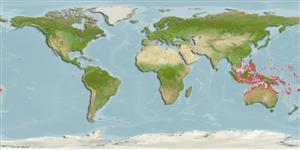Bivalvia |
Cardiida |
Cardiidae
Environment: milieu / climate zone / गहराई सीमा / distribution range
पारिस्थितिकी
; गहराई सीमा 0 - 20 m (संदर्भ 348), usually 0 - 15 m (संदर्भ 75831). Tropical; 23°C - 30°C (संदर्भ 102835); 19°N - 34°S, 100°E - 174°W (संदर्भ 106696)
Indo-West Pacific.
Length at first maturity / आकार / Weight / Age
परिपक्व अवधि: Lm ? range ? - ? cm Max length : 60.0 cm SHL पुल्लिंग / अलिंग; (संदर्भ 348); common length : 50.0 cm SHL पुल्लिंग / अलिंग; (संदर्भ 348)
It is characterized by a low primary and radial sculpture, variable shape, massive umbonal area and smooth white shell.
Locally exploited for meat and shell. This species was previously quite abundant, but has been over collected in many areas. Aquaculture attempts being made (Ref. 348). Found in intertidal areas on corals (Ref. 75831), mainly on reef flats, barrier reefs, fore reefs and atoll lagoons (Ref. 117184). Common in shallow waters wherein juveniles are byssally attached to the tops and sides of coral outcrops. Adults are thought to detach their byssus and settle in clear ocean conditions at 20 m depth (Ref. 101207).
Life cycle and mating behavior
परिपक्व अवधि | पुनरुत्पत्ति | मछलीऔ का अंडे देना | Eggs | Fecundity | Larvae
Life cycle: Embryos develop into free-swimming trocophore larvae, succeeded by the bivalve veliger, resembling a miniature clam (Ref. 833).
SAUP Database 2006 SAUP Database. www.seaaroundus.org. (संदर्भ 356)
IUCN Red List Status
(संदर्भ 130435: Version 2025-1)
CITES status (संदर्भ 108899)
CMS (संदर्भ 116361)
Not Evaluated
Threat to humans
Human uses
मात्स्यिकी: व्यापारिक
FAO - जलीयकृषि: production; | FishSource | Sea Around Us
साधन
अधिक जानकारी
Trophic EcologyFood items (preys)
संघटक आहार
आहार खपत
परभक्षी
PhysiologyOxygen consumption
Human RelatedStamps, coins, misc.
इंटरनेट स्रोत
Estimates based on models
Preferred temperature
(Ref.
115969): 24.7 - 29.3, mean 28.6 (based on 2248 cells).
लौटाव
निम्न, न्यूनतम जनसंख्या दुगनी होने का समय 4.5 - 14 वर्ष। (K=0.11-0.11; tm=4).
Fishing Vulnerability
High vulnerability (57 of 100).
Price category
Unknown.
